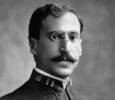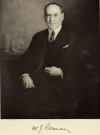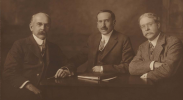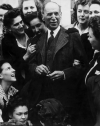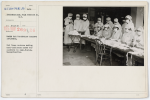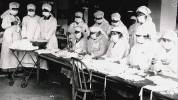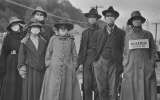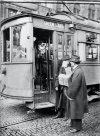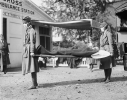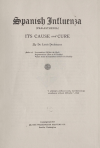





















Excerpt from Rosenau's seminal JAMA article:
"Our next experiment consisted in injections of blood. We took five donors, five cases of influenza in the febrile stage, some of them again quite early in the disease. We drew 20 'c.c. from the arm vein of each, making a total of 100 c.c, which was mixed and treated with 1 per cent, of sodium citrate. Ten c.c. of the citrated whole blood were injected into each of the ten volunteers. None of them took sick in any way. Then we collected a lot of mucous material from the upper respiratory tract, and filtered ' it through Mandler filters. While these filters will hold back the bacteria of ordinary size, they will allow "ultramicroscopic" organisms to pass. This filtrate was injected into ten volunteers, each one receiving 3.5 c.c. subcutaneously, and none of these took sick in any way. [...]
The volunteer was led up to the bedside of the patient; he was introduced. He sat down alongside the bed of the patient. They shook hands, and, by instructions, he got as close as he conveniently could, and they talked· for live minutes. At the end of the five minutes, the patient breathed out as hard as he could, while the volunteer, muzzle to muzzle (in accordance with his instructions, about 2 inches between the two), received this expired -breath, and at the same time was breathing in as the patient breathed out. This they repeated five times, and they did it fairly faithfully in almost all of the instances. After they had done this for five times, the patient coughed directly into the face of the volunteer, face to face, five different times. I may say that the volunteers were perfectly splendid about carrying out the technic [sic] of these experiments. They did it with a high idealism. They were inspired with the thought that they might help others. They went through the program in a splendid spirit. After our volunteer had had this sort of contact with the patient, talking and chatting and shaking hands with him for five minutes, and receiving his breath five times, and then his cough five times directly in his face, he moved to the next patient whom we had selected, and repeated this, and so on, until this volunteer had had that sort of contact with ten different cases of influenza, in different stages of the disease, mostly fresh cases, none of them more than three days old. [...]
CONCLUSION: I think we must be very careful not to draw any positive conclusions from negative results of this kind. Many factors must be considered. Our volunteers may not have been susceptible. They may have been immune. They had been exposed as all the rest of the people had been exposed to the disease, although they gave no clinical history of an attack. Dr. McCoy, who with Dr. Richey, did a similar series of experiments on Goat Island, San Francisco, used volunteers who, so far as known, had not been exposed to the outbreak at all, also had negative results, that is, they were unable to reproduce the disease. Perhaps there are factors, or a factor, in the transmission of influenza that we do not know. As a matter of fact, we entered the outbreak with a notion that we knew the cause of the disease, and were quite sure we knew how it was transmitted from person to person. Perhaps, if we have learned anything, it is that we are not quite sure what we know about the disease."
A. Worth Petty, interviewed by Robert Rodgers Korstad, 10 November 1988 L-0076, in the Southern Oral History Program Collection #4007, Southern Historical Collection, Wilson Library, University of North Carolina at Chapel Hill
John Wright, interviewed by by Robert Rodgers Korstad, 9 September 1988 L-0107, in the Southern Oral History Program Collection #4007, Southern Historical Collection, Wilson Library, University of North Carolina at Chapel Hill
John Edgar Larsh, interviewed by by Robert Rodgers Korstad, 1988 L-0075, in the Southern Oral History Program Collection #4007, Southern Historical Collection, Wilson Library, University of North Carolina at Chapel Hill
*UNC Department of Epidemiology
Dr. Dechman wrote in 1918 on p. 9 et seq.:
"I have not spoken of the use of masks as a preventive measure, but when these much vaunted contrap-
tions are spoken of “it is," as the old proverb says, “very hard not to write a satire." Let us, therefore, try
to forget this greatest farce in the entire history of medicine!
There can be no doubt that the medical fraternity knows nothing as to the cause, and very little, if
anything, about the nature of Spanish influenza, with the inevitable result that the whole medical world
is busy battling against effects. It may be asked, and with very good reason, too, why should medical
scientists find themselves in this position? [...] The medical fraternity of the whole world finds itself
thrust into a cul de sac by Spanish influenza, thanks to the work of two of the great stars of Germany,
namely. Prof. Robert Koch and Prof. Rudolph Virchow! It is not my desire to belittle either the intentions
or the labors of these men. On the contrary, I deeply appreciate the sincere motives and the laborious
experimental work of both. But so far as the results of their work is concerned, the facts themselves are
sufficiently eloquent. It is thirty years since Prof. Koch, discoverer of the tubercle bacillus, announced
that he had found an unfailing cure for tuberculosis, which he named tuberculin. From that day until
this hour, medical science has been chasing its bacteriological phantom. [...] Thirty years ago the
German Reichstag gave Prof. Robert Koch a million marks in appreciation of his great discovery of an
unfailing cure for the terrible plague, tuberculosis. It did not take thirty years to find the futility of Koch’s
tuberculin. The immortal Julius Hensel made clear its failure in 1892, just two years after its discovery
had been announced with trumpets. In spite of the failure of Prof. Koch to find an unfailing cure in more
than thirty years of systematic and laborious work, every student is led to chase the phantom of bacillus
and to concoct more serums. It is in order, I think, to ask, why?
The answer to the foregoing question must lead to consideration of the theory of “Cellular Pathology”
formulated by Prof. Robert Virchow, which was published in 1858. This theory, in a nutshell, is that
changes in the composition of the cells is the first cause of all disease. He does not give the reason for
changes in cell structure. It was this, I may say en passant, which led me to the conclusion that Virchow
was not familiar enough with chemistry, especially with organic chemistry, to enable him to give the
conditions of disease. The results of this colossal error are with us yet."
